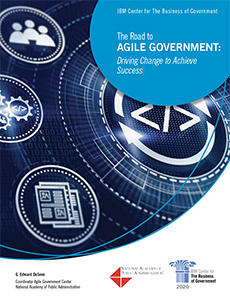
Agile Government: Enabling Successful Action

Today, governments around the world are leading response and recovery efforts to numerous crises, both immediate from the COVID-19 pandemic and long-term such as environmental sustainability. Effective strategies to address these urgent issues must move beyond conventional means of government action, often characterized by bureaucratic hurdles, slow funding streams, and lack of interchange with the public being served by government. Rather, agencies must adopt approaches that enable rapid, nimble, interactive, and mission-focused actions – and those that work across networks rather than up and over hierarchies.
To reach this objective, governments have a model that has proven successful in the technology space: “agile” software development. Introduced two decades ago and now a common element of successful technology ventures, agile development typically involves small, cross-functional, self-organizing teams working quickly to deliver solutions in increments that immediately provide value. Customers are significantly involved in the process. Agile delivery approaches support government goals of economy, efficiency, and effectiveness by improving agency capacity to manage their budgets and delivery dates. Expanding the tenets of agile government to other domains – policy making, regulatory development, and program implementation -- can assist agencies in addressing key challenges and achieving important outcomes.
At the 2019 Fall Meeting of the National Academy of Public Administration (the Academy), a session was devoted to the value of expanding agile across government. At that time, the Academy decided to move forward with the creation of the Agile Government Center (AGC) designed to accomplish three objectives:
- Determine agile government principles (see below for principles)
- Identify and document cases of governments applying agile principles
- Assist in implementing agile government
A year later, on the final day of the 2020 Academy Fall meeting, we are pleased to announce a new report, The Road to Agile Government—Driving Change to Achieve Success, by G. Edward DeSeve, who has led the AGC’s work in a Coordinator role, and is also an Academy Fellow and a Visiting Fellow with the IBM Center for The Business of Government. In the report, DeSeve draws on lessons from agile software development to discuss the benefits of applying agile principles generally, and to describe the AGC’s role in promoting agile practices across agencies specifically. As DeSeve outlines, in the report: “Given today’s challenges, governments can find many compelling reasons for transitioning to an agile environment. These include:
- Bringing together, and moving forward, all parts of an organization or network in a crisis
- Helping to build trust in government by improving outcomes for the public and increasing customer satisfaction
- Reducing the complexity and increasing the efficiency of government.”
The AGC has gained significant momentum by bringing key government, industry, academic, and nonprofit stakeholder groups into a broad coalition—the Agile Government Network— which has developed a set of agile principles to drive government improvement. The Network has also developed case studies of agile government in action for use by government leaders at all levels. The report discusses how application of these principles can improve outcomes and
build public trust in government, and offers several recommendations for leaders going forward.
The IBM Center has had a longstanding focus on how agile techniques can help improve government—prior studies on this topic include A Guide to Critical Success Factors in Agile Delivery, Agile Problem Solving in Government: A Case Study of The Opportunity Project, and Transforming How Government Operates: Four Methods of Change. In addition, the Academy will soon release a study that examines agile government in greater depth, supported by the Samuel Freeman Charitable Trust and the Project Management Institute.
We hope that this report helps government leaders, academic experts, and other stakeholders infuse agile thinking throughout government agencies, leading to better outcomes and improved trust in government.
Agile Government Principles
- Mission: Mission is extremely clear, widely accepted and the organization is laser focused on achieving it.
- Metrics for Success: Metrics are widely agreed upon, outcome-focused, evidence-based, and easily tracked.
- Customer-Driven Behavior: Customers are part of the teams that design and implement agile programs. There is continuous iteration and improvement based on customer feedback.
- External networks: Networks are an important part of leveraging customers and the public.
- Speed: Appropriate speed is essential to produce quality outcomes, regulatory consistency, and a clear focus on managing risks.
- Cross Functional Teams: Empowered, highly-skilled, diverse cross-functional teams and networks lead to improved results
- Innovation: Innovation is rewarded, and rules and regulations that hinder problem solving are examined and changed as necessary.
- Persistence: Persistence requires continuous experimentation, evaluation, and improvement in order to learn from both success and failure.
- Evidence informed solutions: Solid evidence forms the foundation for designing and implementing policy and program options
- Organizational leaders: Leaders eliminate roadblocks, aggregate and assume risks, empower teams to make decisions and hold them accountable, and reward good outcomes.



